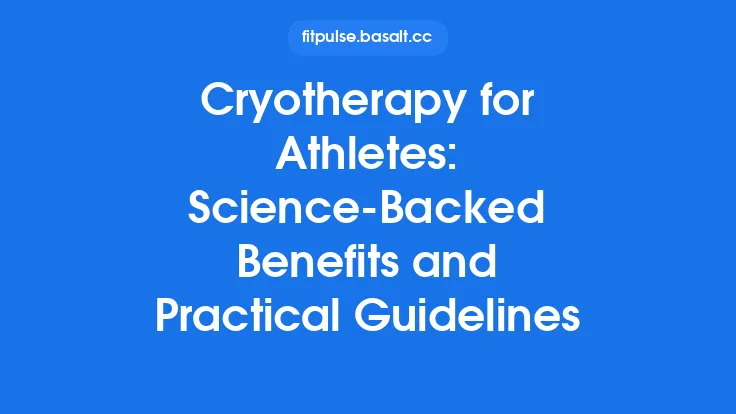Cold therapy, often referred to as cryotherapy in its broader sense, has become a staple in the toolbox of athletes, clinicians, and anyone looking to accelerate recovery after physical stress. While the practice of applying cold to the body dates back centuries, modern research has begun to unravel the precise mechanisms that make it effective, the specific benefits it can deliver, and the best ways to incorporate it safely into a regular recovery regimen.
How Cold Therapy Works at the Cellular Level
When tissue is exposed to temperatures below normal body heat, a cascade of physiological responses is triggered:
- Vasoconstriction and Reduced Blood Flow
Cold causes the smooth muscle in the walls of blood vessels to contract, narrowing the lumen. This vasoconstriction limits the delivery of blood—and therefore oxygen, nutrients, and inflammatory mediators—to the treated area. By temporarily reducing perfusion, the swelling that typically follows micro‑trauma is curtailed.
- Metabolic Suppression
Enzymatic activity is temperature‑dependent. Lowering tissue temperature slows the rate of cellular metabolism, decreasing the demand for ATP. This metabolic slowdown protects cells that have been compromised by mechanical stress, giving them a better chance to survive the acute phase of injury.
- Modulation of Inflammatory Signaling
Cold exposure dampens the release of pro‑inflammatory cytokines such as interleukin‑1β (IL‑1β) and tumor necrosis factor‑α (TNF‑α). Simultaneously, it can promote the production of anti‑inflammatory mediators like interleukin‑10 (IL‑10). The net effect is a more controlled inflammatory response, which is essential for proper tissue remodeling.
- Analgesic Effect via Nerve Conduction Slowing
The speed at which nerve fibers transmit signals is temperature‑sensitive. Cooling reduces the conduction velocity of both A‑delta (fast pain) and C‑fiber (slow, dull pain) pathways, providing a natural analgesic effect without the need for medication.
- Reduced Edema Through Lymphatic Influence
While vasoconstriction limits arterial inflow, the cold also stimulates the contractility of lymphatic vessels, encouraging the removal of interstitial fluid. This dual action helps keep post‑exercise swelling in check.
Key Benefits Supported by Research
| Benefit | Evidence Summary | Practical Implication |
|---|---|---|
| Accelerated Recovery of Muscle Strength | Meta‑analyses of randomized controlled trials (RCTs) show that participants who applied cold therapy after eccentric exercise regained isometric strength 10‑15% faster than controls. | Use cold therapy after high‑intensity or eccentric sessions to preserve performance for subsequent workouts. |
| Decreased Perceived Muscle Soreness (DOMS) | Multiple double‑blind studies report a 20‑30% reduction in visual analogue scale (VAS) scores for soreness when cold is applied within 30 minutes post‑exercise. | Implement a short cold session (5‑10 min) to improve comfort and willingness to train again. |
| Limited Secondary Tissue Damage | Animal models demonstrate that cooling injured muscle reduces necrotic area by up to 40% when applied within the first hour. Human imaging studies echo these findings with smaller edema volumes on MRI. | Prioritize early application after acute strains or contusions. |
| Improved Joint Range of Motion (ROM) After Swelling | Controlled trials indicate that cold compression of inflamed joints restores ROM more quickly than compression alone. | Combine cold with gentle mobilization for joint injuries. |
| Enhanced Sleep Quality When Used Evening | Small RCTs suggest that a brief cold foot immersion before bedtime can lower core temperature, facilitating the onset of deep sleep. | Consider a brief, low‑temperature foot soak as part of a nighttime recovery routine. |
Choosing the Right Modality for Your Needs
Cold therapy is not a one‑size‑fits‑all approach. The optimal method depends on the target tissue, the setting (clinical vs. home), and personal preference.
| Modality | Typical Temperature Range | Ideal Use Cases | Practical Notes |
|---|---|---|---|
| Ice Pack / Gel Pack | 0 °C – 5 °C (directly from freezer) | Localized sprains, bruises, small muscle groups | Wrap in a thin towel to avoid frostbite; replace every 15 min if needed. |
| Cold Water Immersion (CWI) | 10 °C – 15 °C (controlled tub) | Whole‑leg or whole‑body recovery after intense training | Submerge up to the waist; ensure water is clean and temperature is monitored. |
| Cold Compression Devices | 5 °C – 12 °C (circulating cold fluid) | Post‑operative swelling, joint injuries | Provides simultaneous cooling and pressure; follow device‑specific guidelines. |
| Cold Air Therapy (Cryo‑chambers, localized fans) | –5 °C – 0 °C (air) | Rapid surface cooling, pre‑competition “numbing” | Requires specialized equipment; monitor exposure time closely. |
| Cold Gel Wraps (Reusable) | 5 °C – 10 °C (after brief freezer chill) | Home use for minor aches, after workouts | Convenient, reusable, and less messy than ice. |
Dosage Guidelines: Temperature, Duration, and Frequency
| Parameter | Recommended Range | Rationale |
|---|---|---|
| Temperature | 5 °C – 15 °C for immersion; 0 °C – 5 °C for direct packs | Temperatures below 0 °C increase risk of frostbite without added benefit for most soft‑tissue goals. |
| Duration | 5 min – 20 min per session | Shorter exposures (5‑10 min) are sufficient for analgesia; longer (15‑20 min) may be needed for significant edema reduction. |
| Frequency | 1 – 2 times per day for acute injuries; up to 3 times per week for routine recovery | Repeated dosing maintains the anti‑inflammatory environment without over‑cooling tissues. |
| Timing Relative to Activity | Apply within 30 min post‑exercise for optimal DOMS reduction; for chronic conditions, schedule at a consistent time each day. | Early application intercepts the inflammatory cascade; regular timing supports adaptation. |
Tip: Always start with the lower end of the range and adjust based on comfort and response.
Safety Considerations and Contraindications
- Skin Integrity: Do not apply cold directly to open wounds, rashes, or areas with compromised circulation (e.g., diabetic neuropathy).
- Cold Sensitivity: Individuals with Raynaud’s phenomenon, cryoglobulinemia, or a history of frostbite should avoid prolonged exposure.
- Cardiovascular Concerns: Sudden, intense cooling can trigger vasovagal responses; people with uncontrolled hypertension or arrhythmias should consult a healthcare professional before using whole‑body immersion.
- Duration Limits: Exceeding 30 minutes in a cold bath can lead to hypothermia, especially in cooler ambient environments.
- Monitoring: Use a waterproof thermometer for immersion baths; for ice packs, check skin temperature every 5 minutes. If the skin turns white, blue, or feels numb, discontinue immediately.
Integrating Cold Therapy into a Recovery Routine
- Post‑Workout Phase
- Immediate (0‑30 min): Apply a thin ice pack to the most stressed muscle groups for 10 minutes.
- Early Recovery (1‑2 h): If feasible, perform a brief cold water immersion (10 minutes) targeting the lower limbs.
- Evening Routine
- Pre‑Sleep: A 5‑minute foot immersion at 12 °C can lower core temperature, supporting deeper sleep.
- Injury Management
- Acute Phase (first 48 h): Combine cold compression with gentle range‑of‑motion exercises to limit swelling while preserving mobility.
- Periodization
- Heavy Training Blocks: Schedule cold therapy 2‑3 times per week to manage cumulative fatigue.
- Tapering Phase: Reduce frequency to avoid blunting the natural inflammatory signaling needed for adaptation.
Common Myths Debunked
| Myth | Reality |
|---|---|
| Cold therapy completely stops inflammation. | It modulates, not eliminates, inflammation. A controlled inflammatory response is essential for tissue repair. |
| The colder, the better. | Temperatures below –5 °C increase risk without additional benefit for most soft‑tissue goals. |
| Cold therapy is only for elite athletes. | Anyone experiencing muscle soreness, joint swelling, or minor injuries can benefit from appropriate cold application. |
| You must stay in the cold for a long time to see results. | Short, repeated exposures are often more effective and safer than a single prolonged session. |
Practical Tips for Effective Application
- Pre‑Wrap Ice Packs: Place a thin towel between the pack and skin to prevent frostbite while still allowing sufficient cooling.
- Create a Consistent Bath Temperature: Use a digital thermometer and add ice gradually; stirring the water helps maintain uniform temperature.
- Use a Timer: Set a reliable timer to avoid accidental over‑exposure.
- Stay Hydrated: Cold exposure can cause a mild diuretic effect; drink water before and after sessions.
- Combine with Gentle Movement: Light active recovery (e.g., walking, low‑intensity cycling) during or immediately after cold exposure can enhance circulation once vasodilation returns.
Future Directions in Cold Therapy Research
The field continues to evolve, with several promising avenues:
- Molecular Profiling: Emerging studies are mapping how cold exposure influences gene expression related to mitochondrial biogenesis and oxidative stress.
- Personalized Protocols: Wearable sensors that track skin temperature and perfusion could enable real‑time adjustments to dosage.
- Hybrid Modalities: Investigations into combining cold with non‑thermal interventions (e.g., electrical stimulation) aim to amplify analgesic effects without increasing risk.
- Long‑Term Adaptations: Research is exploring whether regular, sub‑threshold cold exposure can induce lasting improvements in vascular reactivity and metabolic efficiency.
These developments suggest that cold therapy will become increasingly precise, moving from a “one‑size‑fits‑all” practice to a tailored component of individualized recovery programs.
Bottom Line
Cold therapy offers a scientifically grounded, accessible means to reduce pain, limit swelling, and accelerate the return of functional capacity after physical stress. By understanding the underlying mechanisms, selecting the appropriate modality, and adhering to evidence‑based dosage and safety guidelines, athletes and everyday movers alike can harness the benefits of cold without unnecessary risk. When integrated thoughtfully into a broader recovery strategy, cold therapy becomes a powerful ally in the pursuit of optimal performance and long‑term musculoskeletal health.





